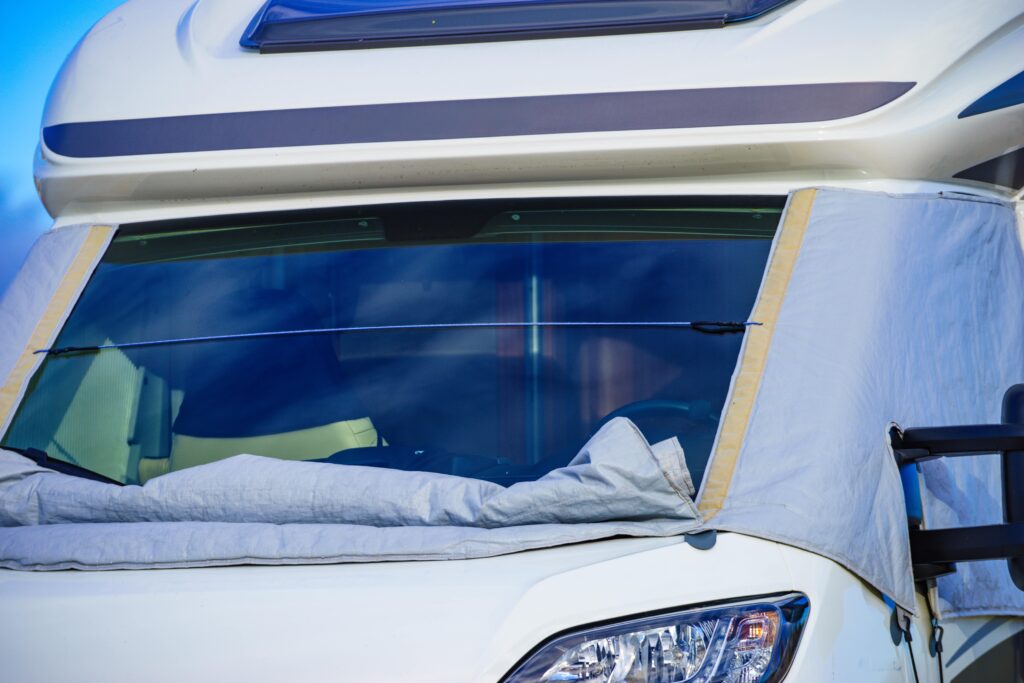Why Do you Need a Motorhome Cover and How to Put One On
3 minutes well spent

Protecting your motorhome is essential to ensure it remains in top condition for years to come. One effective way to safeguard your investment is by using a motorhome cover. This article explores the importance of motorhome covers, the different types available, guidance on selecting the right one, and a step-by-step guide to proper installation.
1. Why Do You Need a Motorhome Cover?
Motorhomes are exposed to various environmental factors that can lead to wear and tear. A quality motorhome cover offers protection against:
- UV Radiation: Prolonged exposure to sunlight can cause fading and cracking of your motorhome’s exterior. A cover with UV protection helps prevent this damage.
- Weather Elements: Rain, snow, and ice can lead to moisture accumulation, resulting in mould, mildew, and corrosion. Water-resistant covers act as a barrier against these elements.
- Environmental Debris: Bird droppings, tree sap, and dust can mar the appearance of your motorhome and may be difficult to clean. A cover keeps these nuisances at bay.
- Security: A covered motorhome is less visible to potential thieves, adding an extra layer of security.
2. Types of Motorhome Covers
Selecting the appropriate cover depends on your specific needs and the environment in which your motorhome is stored. Common types include:
- Polypropylene Covers: Breathable and water-resistant, suitable for areas with high humidity to prevent mould growth.
- Polyester Covers: Durable and lightweight, often treated for UV resistance, ideal for sunny climates.
- Multi-Layer Covers: Constructed with multiple layers for enhanced protection against harsh weather conditions, including heavy rain and snow.
3. How to Choose the Right Motorhome Cover
When selecting a cover, consider the following factors:
- Size and Fit: Measure your motorhome’s length, width, and height accurately, including any attachments like ladders or air conditioning units, to ensure a snug fit.
- Material Quality: Opt for materials that offer breathability to prevent moisture build-up and are treated for UV and water resistance.
- Climate Considerations: Choose a cover suited to your local weather conditions. For instance, in rainy areas, prioritise waterproofing; in sunny regions, UV protection is key.
- Ease of Use: Look for covers with features like zippered panels for easy access and adjustable straps for secure fitting.
4. How to Put a Motorhome Cover On
Proper installation of your motorhome cover ensures maximum protection. Follow these steps:
- Preparation:
- Clean the Exterior: Remove dirt and debris from your motorhome to prevent scratches.
- Inspect for Damage: Ensure there are no sharp edges that could tear the cover.
- Installation:
- Unpack and Unfold the Cover: Lay it out on a clean surface to identify the front and back.
- Position the Cover: Starting from the front, drape the cover over the motorhome, working your way to the back.
- Secure the Cover: Use the provided straps and buckles to fasten the cover, ensuring it is taut but not overly tight.
- Final Adjustments:
- Check All Sides: Ensure the cover is evenly positioned and covers the entire motorhome.
- Access Points: Utilise zippered panels to access doors or compartments without removing the cover.
5. Common Mistakes to Avoid
To maximise the lifespan of your motorhome cover and vehicle, avoid these common pitfalls:
- Improper Sizing: Using a cover that doesn’t fit correctly can lead to inadequate protection and potential damage. Always measure your motorhome before purchasing a cover.
- Neglecting to Clean Before Covering: Dirt and debris can scratch the surface if trapped beneath the cover. Ensure the motorhome is clean prior to installation.
- Inadequate Securing: Failing to fasten the cover properly can result in it being dislodged by wind. Use all provided straps and check them regularly.
- Ignoring Ventilation: A cover without proper ventilation can trap moisture, leading to mould and mildew. Choose a breathable material and ensure vents are unobstructed.
Investing in a high-quality motorhome cover is a proactive step in preserving your vehicle’s condition and value. By selecting the right type and ensuring proper installation, you can protect your motorhome from environmental hazards and extend its lifespan.
We’ve got 100s of new and used stock for you to discover

